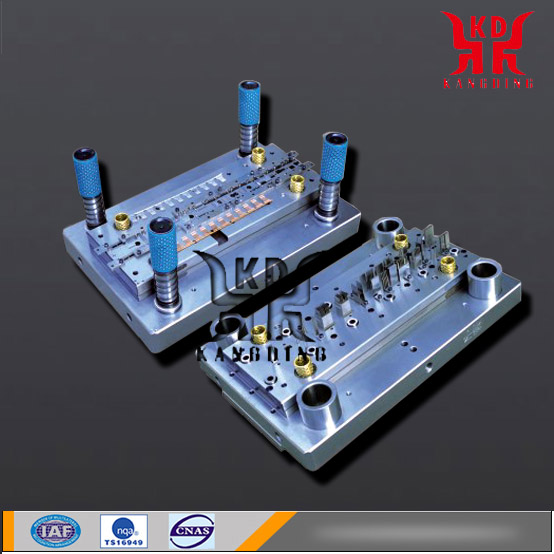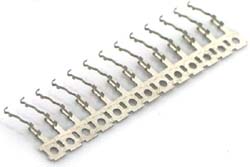Drawing Die Material Selection And Heat Treatment Process

(1) Mold materials for deep drawing (drawing of sheet steel and copper, aluminum alloy) at light load:
When the production volume is small, T8 and T10 steels can be used for the simple shape of the tube or shallow drawing parts. For small and medium-sized parts with complex shapes, use CrWMn and 9Mn2V. Select Cr12MoV for mass production or larger production batches. When the production volume is large, carbide or steel cemented carbide is selected.
(2) Mould materials for deep drawing (drawing thick steel plate, reverse drawing, thinning drawing) at heavy load:
When the production volume is small, T10 and CrWMn can be used. When the production volume is large, Cr12MoV and GM steel are used. GM steel is higher in strength and toughness than high speed steel, Cr12MoV; The anti-adhesive and abrasive wear resistances are significantly better than those of the base steel and Cr12MoV, and have been well applied in the drawing die. When the production volume is large, consider the use of carbide or steel cemented carbide.
(3) Die material for deepening stainless steel, high nickel alloy steel, and heat-resistant steel plate:
When these materials are deepened, adhesion and drawing easily occur. The preferred mold material is aluminum bronze. When the production volume is small, aluminum bronze and T10A (hard chrome plated) can be used. Note that when the hard chrome plating process is used, the coating cannot be too thick to prevent peeling when deep drawing. When the production volume is large, aluminum bronze, Cr12MoV, and Cr12Mo1V1 (surface nitriding) are used. When the production volume is large, carbide is selected.
(4) Large deep drawing parts, drawing mold materials for automobile covers
Alloy cast iron or high-strength ductile iron can be selected. Ductile iron can be immersed in lubricating oil. The graphite in the structure has a self-lubricating effect, can effectively reduce the friction in deep drawing, and has a low cost and is easy to process. High-strength ductile iron can be used in dual-media delayed cooling martensite austempering to obtain high strength and toughness, hardness 55 ~ 58 HRC. The mold is slowly preheated and then heated to 880~900 °C. After the insulation, the air is precooled first, then the brine is quenched to about 550 °C, and then it is transferred to oil cooling. When the mold temperature drops to about 250 °C, the hot oil placed in 180-200 °C is maintained at medium temperature for 2 to 3 hours, then the oil temperature is reduced to about 170 °C for 5 to 7 hours, and finally it is transferred to air cooling.
Cr12MoV
Cr12MoV steel has high hardenability. The cross section of 300 ~ 400mm can be completely hardened, and can maintain good hardness and wear resistance at 300 ~ 400 °C. The toughness is higher than that of Cr12 steel, and the volume change during quenching is minimum. .
It can be used to make various molds and tools with large sections, complex shapes, and large impact loads.
For example, punching dies with complex shapes, inserts on complex dies, Deep drawing die, drawing die, Screw threading plate, cold extrusion die, Cold cutting scissors, circular saw, Standard tools, measuring tools, etc.
Introduction Features Alloy Tool Steel: Cr12MoV[1]
Standard: GB/T 1299-2000
Scope of application
Cold working die steel, steel hardenability, quenching and tempering hardness, wear resistance, strength are higher than Cr12. It is used to manufacture various cold punching dies and tools with large cross section, complicated shape and heavy working conditions. Such as punching die, trimming die, piping die, steel deep drawing die, circular saw, standard tools and gauges, thread rolling die and so on.
Corresponding brand
China GB Standard Grade:
The special steel cr12mov, China Taiwan cNS standard brand SKD11, German DlN standard material No. 1.26o1, German DIN standard No. x165CrM0v12, Japan Jis standard brand sKD11, South Korea Ks standard brand sTD11, Italy UN1 standard brand, x165CrM0W12KU, Swedish SS standard brand 2310, Spain UNE standard grade X160CrM0V12, USA AISi/sAE standard grade D3, Russia roCT standard grade x12M.
Physical properties
Cr12MoV is the national standard, German standard is called: X165CrMoV12 Chemical composition:
Carbon C: 1.45 to 1.70
Silicon Si:≤0.40
Manganese Mn: ≤ 0.40
Sulfur S: ≤0.030
Phosphorus P: ≤ 0.030
Chrome Cr: 11.00 to 12.50
Nickel Ni: Permissible residual content ≤ 0.25
Copper Cu: Permissible residual content ≤ 0.30
Vanadium V: 0.15 to 0.30
Mo Mo: 0.40 to 0.60
Mechanical properties:
Hardness: annealing, 255 ~ 207HB, indentation diameter 3.8 ~ 4.2mm; quenching, ≥ 60HRC
Cr12MoV use
Cr12MoV mold steel hardenability, quenching and tempering after the hardness, strength, toughness than CR12, the workpieces with a diameter of 300~400mm can be completely hardened, and the quenching deformation is small, but the high temperature plasticity is poor. Cr12MoV is mostly used to make molds and tools with large cross-sections, complex shapes, and heavy work loads. Such as piercing die, cut-off die, roller die, steel plate and so on.
Heat treatment specification
Heat treatment specifications: 1. Quenching, 950 ~ 1000 °C oil cooling; 2. Quenching 1020 °C, 200 °C tempered 2h.
Metallographic structure: fine-grained pearlite + carbide.
Delivery status: Steel is delivered in an annealed condition.
Ordinary isothermal spheroidizing specification
850 ~ 870 °C × 3 ~ 4h, with furnace cooling to 740 ~ 760 °C × 4 ~ 5h isothermal, baked air-cooled hardness ≤ 241HBW, eutectic carbide grade ≤ 3, the best isothermal temperature 740 ~ 76o °C, time ≥ 4 ~ 5h
Spheroidizing annealing specification
(860 ± 1 ü) °C × 2 ~ 4h, cooled at 30°C/h in the cold speed furnace, (740 ± 10) °C x 4-6h, slowly cools with the furnace to 500 ~ 600 °C, baked and cooled, hardness 207 ~255HBW.
Cryogenic treatment
Crl2MoV steel undergoes cryogenic treatment, and cryogenic treatment allows quenched martensite to precipitate highly dispersed ultrafine carbides. After subsequent low-temperature tempering at 200°C, these ultrafine carbides can be converted into carbides. In the martensite without cryogenic treatment, only a small amount of carbide precipitated in some local areas after tempering at low temperatures. Crl2MoV adopts low-temperature chemical heat treatment method, on the basis of maintaining high hardness and high wear resistance of Crl2MoV steel, ion nitriding, gas nitrocarburizing, salt bath thiocyanidation, commonly used low-temperature chemical heat treatment adhesion layer adhesion resistance. Low-temperature chemical heat treatment, the penetration layer has a significant impact adhesion, especially in the salt bath thiocyanide best. Crl2MoV steel is used to make tensile dies for stainless steel vessels. After gas nitrocarburizing treatment, the service life reaches more than 30,000 pieces.Compared with conventional quenching and tempering, the life of similar molds is increased by more than 10 times.
Hardening process
In order to increase the die life to more than 800,000 times, the hardened steel can be hardened and low temperature tempered.
When quenching, it is preheated at 500-600°C for 2-4 hours, then kept at 850-880°C for a certain period of time (at least 2 hours), put into oil and cooled to 50-100°C to make oil and air cooled. Hardness after quenching up to 50-52HRC, in order to prevent cracking should be immediately performed at low temperature tempering 200 °C, after tempering, the hardness can be maintained above 48HRC
Salt bath vanadium treatment
Crl2MoV cold work die steel neutral salt bath infiltration of vanadium processing technology, Crl2MoV steel by neutral salt bath infiltration of vanadium treatment carbide layer can be obtained.
1. Carbon vanadium compounds, which have uniform organization, good continuity and compactness, uniform thickness, compact structure, high microhardness, high wear resistance, surface hardness, anti-adhesive properties, etc. substantial improvement.
2. The solubility of VC in austenite is higher than its solubility in the iron wire. With the decrease of temperature, VC is precipitated from the wire, making the alloy strengthening and grain refinement. The compound layer shows a higher hardness. Cr12MoV is a high-carbon, high-chromium, mineel steel with a high content of carbides, accounting for about 20%, and is often unevenly distributed in strips or networks. Segregation is severe, and conventional heat treatment can hardly change the segregation of carbides. Affects the mechanical properties of steel and the service life of the mold. The shape and size of carbides also have a great influence on the performance of steel. In particular, large, sharp-edged carbides have a large split effect on steel substrates. It is often the source of fatigue and fracture. For this reason, raw material rolled steel must be forged. The eutectic carbides are sufficiently broken to make them fine and evenly distributed. The fibrous structure surrounds the cavity or is non-directionally distributed, thereby improving the transverse mechanical properties of the steel.
During forging, the billet is upset and drawn from different directions several times, and forged by the “two light one weight” method. That is, when the billets are to be forged, they must be lightly tapped to prevent breakage, and they can be hit hard at an intermediate temperature of 980 to 1020 °C to ensure the crushing of carbides. Cr12MoV steel has not been forged, using solid solution double refinement, That is, two-level preheating at about 500 °C and 800 °C, solution treatment at 1 100 to 1 150 °C, quenching into hot oil or isothermal quenching, and tempering at 750 °C, after heat treatment at 960 °C, the final heat treatment can be performed to refine the carbides, round corners, and refine the crystal grains.
5. Tempering
Recommended tempering specification for Cr12MoV steel
| Program | Quenching temperature / °C | Backfire | Quenching | ||
| Uses | Heating temperature/°C | Media | Hardness HBW | Media | Hardness HRC |
|
Ⅰ Ⅱ Ⅲ |
1020~1040 |
Stress relieved stress relieved, reduced hardness stress relieved, reduced hardness |
150~170 200~275 400~425 |
Oil or salt — — |
61~63 57~59 55~57 |
|
Ⅳ Ⅴ Ⅵ |
1115~1130 |
Remove stress and form secondary hardening Remove stress and form secondary hardening Remove stress and form secondary hardening |
510 ~ 520 °C tempered many times -78°C cold treatment Add 510 ~ 520 °C once tempered -78 °C cold treatment plus a 510 ~ 520 °C tempering, and then -78 °C cold treatment |
— — — |
60~61 60~61 61~6 |
6. Quenching
| Program | First warm-up/°C | Second warm-up/°C | Quenching temperature/°C | cool down | Hardness (HRC) | |||
| Media | Media temperature/°C | In media cooling | Followed by | |||||
|
Ⅰ Ⅱ Ⅲ Ⅳ Ⅴ |
550~660 | 840~860 |
950~1000 1020~1040 1020~1040 1115~1130 1115~1130 |
oil oil Molten nitrate oil Molten nitrate |
20~60 20~60 400~550 20~60 400~450 |
To room temperature To oil temperature 5~10min To oil temperature 5~10min |
Air cooling |
58~62 62~63 62~63 42~50 42~50 |
1. Schemes II, III are used to require high mechanical properties and deformation of the workpiece, such as threaded rollers, reeling plates, molds with complex impact loads, etc.;
2. Schemes IV and V are used to obtain red hardness and wear resistance of the workpiece, but poor mechanical properties, large size deformation, such as hot stamping work below 450 °C;
3. This kind of steel is very sensitive to decarburization. The salt bath for preheating and heating must be fully deoxidized before use.
If heated in an ordinary electric furnace, the workpiece can be loaded into the box and filled with carburizing agent or pig iron powder (in this case, the workpiece may have a little carbon increase, and the hardness can be increased by HRC1~2).
Table 2-3-1 Ratio of Tissues in Quenched State
| Quenching solution | cool down | Carbide/% | Martensite/% | Austenite/% |
| Ⅰ、Ⅱ | Oil, salt | 12 | 73~68 | 20~23 |






